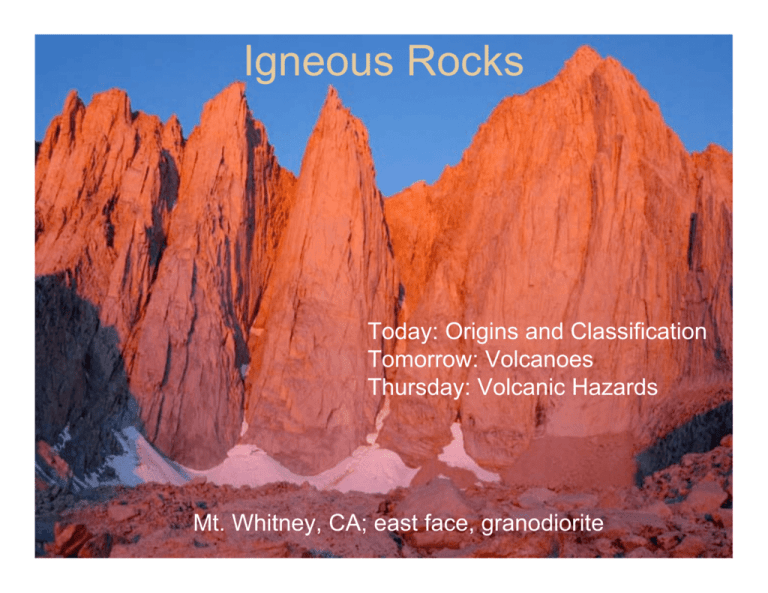Igneous Rocks - De Anza College
advertisement

Igneous Rocks Today: Origins and Classification Tomorrow: Volcanoes Thursday: Volcanic Hazards Mt. Whitney, CA; east face, granodiorite Pressures and Temperatures of Earth Temperature (and pressure) increase with depth in the Earth’s crust. The high temperature is due to heat left over from planetary accretion (when Earth was formed) and radioactive decay of elements in the mantle and core. How Melting Happens Rocks are solid but under the high pressures and temperatures of the crust at depth, rock melts to magma. The composition of the magma determines what temperature and pressures will make the melt into solid crystals Water lowers the melting temperature of rock. Water at plate boundaries is a major factor in generating magma. Terms Texture - size, shape, distribution and spatial relationship of minerals or components of a rock. Composition - the chemical nature of the minerals or matrix that makes up the rock. Matrix - the predominant background material that makes up a rock; sometimes called groundmass. El Capitan granodiorite, medium grained texture Vein of material in a fine grained matrix Uncut diamond in kimberlite matrix Classification Schemes 1. Textures - fine grained (aphanitic) or coarse grained (phaneritic). Porphyritic means both sizes. Special cases phenocrysts, xenocrysts, megacrysts. 2. Composition - minerals, colors; mafic (meaning close to a basalt; Fe, Mg), intermediate or felsic (rich in felspars, Si, K). 3. Origin of the rock - intrusive, extrusive 4. Relationship to surrounding rocks - what does it intrude? How was it extruded? Texture Intrusive - determined by rate at which the material was cooled, and relationship to host rock. Extrusive - determined by process by which the rock was extruded, as well as interactions with water and gases. Texture is also indirectly affected by composition. Sketch of crystals forming in a magma chamber Ash plume due to water and gas Three generations of dikes intruding granite. Composit ions range from mafic to felsic. Composition Mafic - composed of minerals containing Fe and Mg that form early in the sequence. Dark colored and less stable on the surface. Example: basalt (extrusive), and diorite (intrusive). Intermediate - Both types of mineral, mixed color. Felsic - composed of minerals containing Si and K (feldspars and quartz) that form later in the sequence. Light colored and more stable on the surface. Example: rhyolite (extrusive) and granite (intrusive). Mafic - diabase; intrusive Intermediate - andesite; extrusive Felsic - granite; intrusive Exception: Obsidian Obsidian outcrop Rare banded, translucent obsidian Obsidian is volcanic glass, and classifies as an extrusive rock. The molecules are completely disordered meaning they have no lattice. Obsidian is usually dark but is made of felsic material, namely SiO2 (up to 70%). Bowen’s Series Igneous minerals crystallize in an order with decreasing temperature Mafic Minerals Olivine - (MgFe)2SiO4 Rock = peridotite (olivine and pyroxenes) Pyroxene - (XY)SiAl2O6 Where XY = Na,Ca, Fe, Mg Rock = gabbro (pyroxene and plagioclase Felsic Minerals Alkali Feldspar - (X)AlSi3O8 Where X = Ca, Na, K May make up to as much as 60% of the crust. Quartz - SiO2; gray, may only make up no more than 60% of the rock if it is an igneous rock. Extrusive Processes Plumes - ash, tiny fragments + gas Flows - magmas, magma + ash + water mixtures Twin Falls, ID; Columbia river basin flood basalts Mt. St. Helens, 1980 Instant cooling - crystals do not have time to form. How was it extruded? How far did it travel? Where did it flow or fall (on water or land?) Is it layered? Lava / Basalt Examples of different styles: Pahoehoe - ropey, smooth flowing A a - chunky, brittle, sounds like breaking glass as it flows Vesicles: bubbles formed in the rock from the exsolving of gas when rock was still molten. ‘Vesicular’ is a kind of texture. Terms Pumice has small vesicles and floats in water. Pryoclastic: a volcanic rock that was transported by air, water or its own viscocity. Clasts can be tiny or giant. Tephra - tiny SiO2 ash fragments; note vesicles Scoria has larger vesicles and sinks in water. Volcanic bomb from Aso volcano, Japan - note roundness Intrusive Depth: a pluton is emplaced deep within the lithosphere whereas hypabyssal bodies make it to shallow regions Crystals are Relative Phaneritic - large crystals with well defined boundaries. Aphanitic - very small crystals, not necessarily visible. Porphyritic - both large and small crystals. Phenocryst - crystal of a different size Megacryst - huge crystal Xenocryst - crystal of a different origin Crystal Textures Finer grained, approaching aphanitic Phaneritic with felspar phenocrysts What makes a rock porphyritic? Summary Igneous rocks are classified according to: Intrusive or Extrusive Textures Compositions Minerals Crystal relationships, boundaries Relationship to host rock







![MULTIPLE CHOICE [1 point each]](http://s3.studylib.net/store/data/007665914_2-53fdb5abcde5d4f4017c3aa52e17df22-300x300.png)